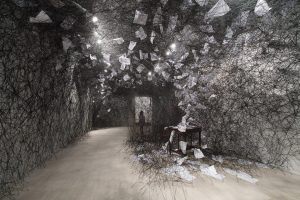The 2017’s edition of the Socle du Monde Biennale, the oldest Biennale of Denmark, is named after Piero Manzoni’s epoch making artwork from 1961 Socle du Monde and strives in its 7th edition for new perspectives. Not only a tribute to Manzoni, it pays homage to all great artists, before and after, who accepted the challenge of turning our world upside down. Between April 22 and August 27, 2017 more than 60 international artists from three generations and a renowned curatorial team experiment with the past, the present, and the future. The Biennale is subtitled To challenge the Earth, the Moon, the Sun and the Stars – how the biennale’s artists, works and topics are related to this theme will be reframed in the following sections.
To challenge the Earth
It’s the planet we love, take care of, live on, experience, destroy, and harm. Having reached an age of 4,5 × 10^9 years, the Earth has survived tremendous changes. The blue planet bears the marks of these shifts, which determine the nature of life on its surface. A complex solar system is its home, and without it, we wouldn’t be alive. Oxygen, water, light, darkness — many elements shape terrestrial life, inspiring and amazing influential artists like Heinz Mack:
Heinz Mack is one of the founders of the ZERO artist group. In 1961 his friend and cofounder artist Otto Piene, proclaimed:
“A look to the sky, to the sun, to the ocean is enough to show that the world outside of human beings is bigger than the world within them”
The ZERO Group took a step back, by recognizing its beauty and natural phenomena. Contemporary artists are also still discovering new features, anomalies, and curiosities in the natural world. Light and shadow and other physical phenomena are sources of inspiration for many artists. For example, artist Keisuke Matsuura challenges the disorder of nature by contrasting it with flawless structures and by emphasizing a range of environments.
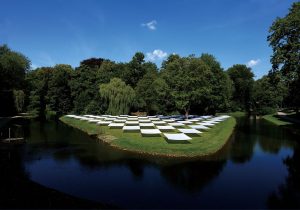
While others focus on the Earth’s phenomena and potential, artists like Herman de Vries take the approach of collecting samples of nature’s beauty and diversity.
And for those who yearn to experience life beyond Earth, Studio Tomás Saraceno has created a starter kit for the personal exploration of the atmosphere: The Aerocene Explorer. Let’s get up in the sky and see our planet from different perspectives.

Apart from the complexity of the planet, there is also the individual story of every being on earth. We live in a chaotic, digital age poised between love and hatred. Tolerance and racism are once again driving some of the biggest debates on earth. Artists use their own special language to send messages out into society. The artist duo Hesselholdt & Mejlvang created a clean, clinique, white room that turns into a room of hate messages when UV light switches on.
The Invisible Territory – Hesselholdt & Mejlvang
White culture. Kill all you faggots now. Off with his head. A white room turned into a world of hatred and racism: “The Invisible Territory” by Sofie Hesselholdt & Vibeke Mejlvang – in the Herning Højskole @ Socle du Monde Biennale.
Posted by Socle du Monde Biennale on Dienstag, 2. Mai 2017
But does art simply exist on Earth, or is the Earth itself a work of art? The artist Piero Manzoni created the work Socle du Monde, a cube with bronze letters spelling out “pedestal of the world” in French. But the writing is upside down. Or is actually the earth upside down? Manzoni’s work turns the entire world into an artwork, and turns visitors’ perspectives upside down.

To challenge the Moon
384,400 kilometers away, the silent moon is an essential part of our days — or better said, our nights. Illuminated by the sun, the moon spends light in the darkness. The moon also reflects some of the sun’s heat to the earth. This natural satellite is the driving force behind the tides.
But more than any other heavenly body in our solar system, the moon stands for darkness, melancholy, and sadness. At the same time, the consistent cycles of the moonrise and moonset mark the start of every day – and serve as symbols of happiness and infinity. The artist Yayoi Kusama is a survivor of her own personal darkness. Suffering from depersonalization disorders, she has lived in a psychiatric hospital since 1977. The repeating patterns of her artworks help her combat suicidal thoughts.
She escaped insanity thanks to art.
Posted by PlayGround + on Montag, 21. November 2016
After a dark period in Japanese history, a radical, postwar artistic group, the Gutai Group, was founded in 1954, which stressed freedom of expression through the use of innovative materials and techniques. In 1962 the group mounted an exhibition called:
“Don’t worry, the Moon won’t fall down!”
If the moon won’t come to us, we’ll go to the moon – and when we go, art comes along. At least the artwork of Paul Van Hoeydonck! He was the first artist to create an artwork for the moon. His work Fallen Astronaut was placed there during the Apollo 15 mission in memory of 14 fallen astronauts.
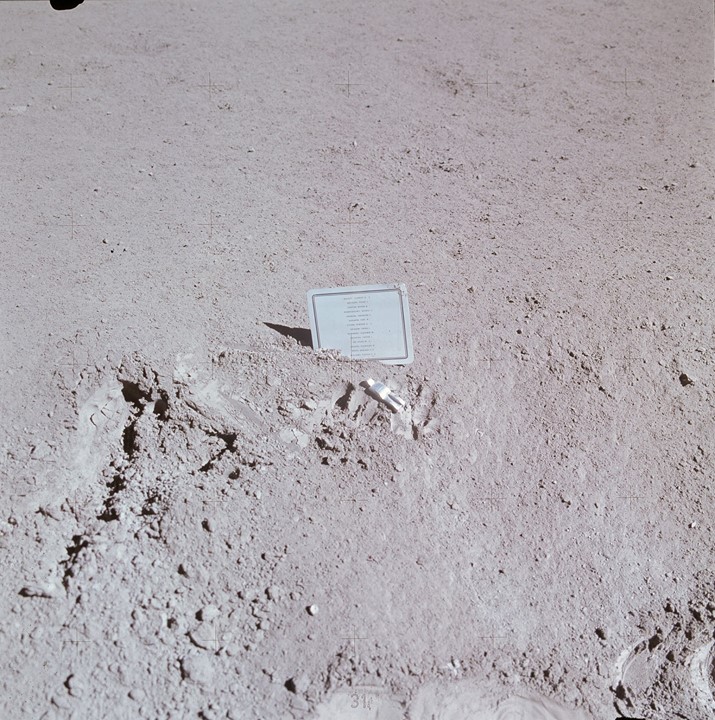
Discovering the moon and finding out how it might be to live there offers a ray of hope in terms of escaping catastrophes on earth. It represents our passionate research towards understanding the universe we live in. The complex interaction of different planets in an enormous solar system is mind-blowing. Artists like Cameron Robbins have transformed the system’s natural movements into art. At this year’s Socle du Monde Biennale Robbins presents a drawing machine, which is powered by wind and weather and creates marks on paper.
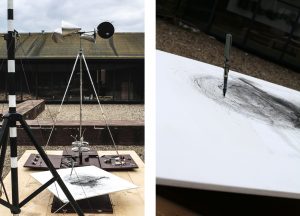
To challenge the Sun
Giant, powerful, hot, and vital – the sun, with a diameter 109 times that of the earth’s, is a large star at the center of our solar system. The sun is essential to human life. Light and heat are given off by this giant in the sky. It is the sun that we celebrate after a dark and grey day. We gratefully enjoy the summer’s heat or the beautiful morning light that wakes us.
When the sun shines, our bodies produce serotonin – the “happiness hormone.” No other planet has that much power – both in the sense of “raw” energy and in terms of altering our moods. Having sun means enjoying life. Being happy, happy with yourself, with your body, with imperfection — or perfection?
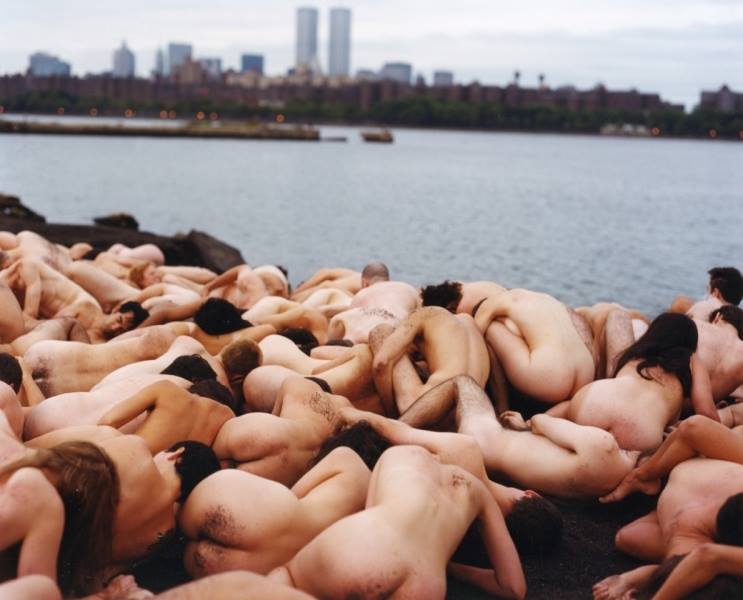
Spencer Tunick’s mass compositions of nude bodies make his models seem as alterable as light. The sun’s light has inspired many artists. Several generations of artists have worked with this natural phenomenon. Contemporary artists are still impressed by light. Conrad Shawcross creates mechanical systems that produce moving light and patterns; their tempo is powered by a unique piece of music:
Light is always accompanied by shadow. Light illuminates but it also creates shadow. How does an object look when it’s lit from one side or the other? What do you see when confronted by a very bright light or very dim light? What kind of lighting creates certain atmospheres? The effects of light and optical phenomena are a main subject in the works of ZERO artist Günther Uecker. Departing from two-dimensional objects, he created works that evoke a special sense of light, space, movement, and time.
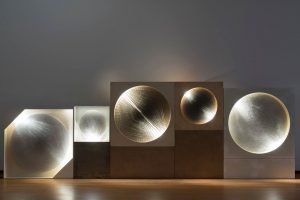
Beyond light, the sun also brings heat. It is violent. It is fire. Installed on the site of the Socle du Monde Biennale in Herning the sculpture Elia by artist Ingvar Cronhammar randomly emits flames 10-meters high. The mysterious work functions with a gas generator controlled by a computer system.
To challenge the Stars
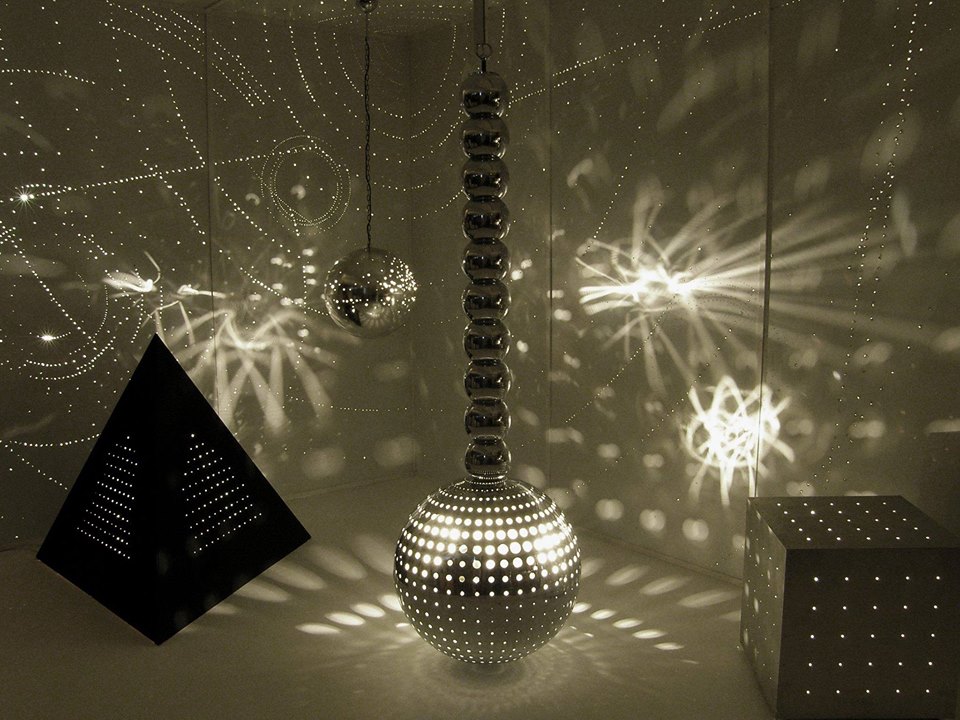
Appearances are deceiving – little stars in the sky can actually be enormous stars. Don’t judge something or somebody by their appearance! Bringing people together, believing that all human beings shine with their special personalities, and promoting team spirit are all goals of Rirkrit Tiravanija’s live installations, in which people share meals, cook, read, or play music together.

Teams, communities, and networks – in our sky the stars seem to exist in a network. We see stellar constellations and try to identify forms and figures. Everything seems to be connected: stars in the sky, human beings, cells in our body, and nerve cords in our brain. The artist Chiharu Shiota creates striking webs of yarn, which reminds us of the connections that make up our lives — bonds with friends and family, society, or our own selves. As large-scale installations, her works are an immersive experience.
